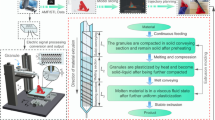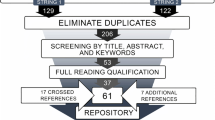Abstract
Considering the problems faced by Fused Deposition Modeling (FDM) 3D printing equipment, including limited consumables choices and unstable extrusion rate as well as difficult prints precision control, etc., a new type of 3D printing molding equipment was designed following the current screw extrusion technology combined with 3D printing molding mechanism. Also, the optimal matching relation between the rotational speed of the screw, which is the core of the equipment, and the feed rate of the nozzle was determined. The POLYFLOW, the software of finite element numerical simulation, was employed for analyzing the performance of the screw module under different working conditions. The result revealed that the outlet fluid pressure derived from the theoretical calculation (1.48 MPa) was close to the simulation value of 1.51 MPa, and the volumetric flow rate at the outlet derived from theoretical calculation 3.51 × 10–8(m3/s) was close to the value obtained from simulation (3.18 × 10–8 (m3/s). Those findings indicated that the material could be extruded at a constant output rate; with the increase of the screw lead size, the pressure build-up capacity of screw improved, and the pressure fluctuation and velocity change became more intensive; therefore, the lead within the range of 24 ~ 36 mm should be the suitable choice for the application in actual production; the reduction of the rational speed resulted a lower shear rate, therefore, the screw rotational speed should be optimized within the reasonable range of 8 ~ 15r/min (Nmax ~ Nmin) and the feed rate of nozzle should be selected within the range of 1043.33 ~ 746.24 mm/min (VFmax ~ VFmin).
















Similar content being viewed by others
Data Availability
The datasets generated during and/or analyzed during the current study are available from the corresponding author on reasonable request.
References
Gao, W., Zhang, Y., Ramanujan, D., Ramani, K., Chen, Y., Williams, C. B., Wang, C. C., Shin, Y. C., Zhang, S., & Zavattieri, P. D. (2015). The status, challenges, and future of additive manufacturing in engineering. Computer-Aided Design, 69, 65–89.
Singh, R., & Garg, H. K. (2016). Fused deposition modeling–a state of art review and future applications. Reference Module in Materials Science and Materials Engineering. https://doi.org/10.1016/B978-0-12-803581-8.04037-6
Tseng, J.-W., Liu, C.-Y., Yen, Y.-K., Belkner, J., Bremicker, T., Liu, B. H., Sun, T.-J., & Wang, A.-B. (2018). Screw extrusion-based additive manufacturing of PEEK. Materials & Design, 140, 209–221.
Thermwood. (2018). Thermwood unveils new 3d print head design. http://additivemanufacturing.com/2017/05/25/thermwood-unveilsnew-3d-print-head-design/. Accessed 29 May 2018.
Silveira, Z. C., Freitas, M. D., Neto, P. I., Noritomi, P. Y., & Silva, J. (2014). Study of the technical feasibility and design of a mini head screw extruder applied to filament deposition in desktop 3-d printer. Key Engineering Materials, 57, 151–154.
Kong, T., Stone, H. A., Wang, L., & Shum, H. C. (2018). Dynamic regimes of electrified liquid filaments. Proceedings of the National Academy of Sciences, 115(24), 6159–6164.
Hu, D., & Chen, J. (2005). Meshing direction twin-screw extruder screw combination in the performance of the numerical study (II) feature analysis. Chinese Plastics, 12(6), 103–109.
Orefice, L., & Khinast, J. (2017). DEM study of granular transport in partially filled horizontal screw conveyors. Powder Technology, 305, 347–356.
Villmow, T., Kretzschmar, B., & Pötschke, P. (2010). Influence of screw configuration, residence time, and specific mechanical energy in twin-screw extrusion of polycaprolactone/multi-walled carbon nanotube composites. Composites Science and Technology, 70(14), 2045–2055.
Sarhangi Fard, A., Hulsen, M. A., Meijer, H. E., Famili, N. M., & Anderson, P. D. (2012). Tools to simulate distributive mixing in twin-screw extruders. Macromolecular Theory and Simulations, 21(4), 217–240.
Aslanzadeh, S., Saghlatoon, H., Honari, M. M., Mirzavand, R., Montemagno, C., & Mousavi, P. (2018). Investigation on electrical and mechanical properties of 3D printed nylon 6 for RF/microwave electronics applications. Additive Manufacturing, 21, 69–75.
Wang, S., Badarinath, R., Lehtihet, E.-A., & Prabhu, V. (2017). Evaluation of additive manufacturing processes in fabrication of personalized robot. International Journal of Automation Technology, 11(1), 29–37.
Spackman, C. C., Frank, C. R., Picha, K. C., & Samuel, J. (2016). 3D printing of fiber-reinforced soft composites: Process study and material characterization. Journal of Manufacturing Processes, 23, 296–305.
Lunetto, V., Priarone, P. C., Galati, M., & Minetola, P. (2020). On the correlation between process parameters and specific energy consumption in fused deposition modelling. Journal of Manufacturing Processes, 56, 1039–1049.
Rackl, M., & Günthner, W. A. (2016). Experimental investigation on the influence of different grades of wood chips on screw feeding performance. Biomass and Bioenergy, 88, 106–115.
Geng, P., Zhao, J., Wu, W., Ye, W., Wang, Y., Wang, S., & Zhang, S. (2019). Effects of extrusion speed and printing speed on the 3D printing stability of extruded PEEK filament. Journal of Manufacturing Processes, 37, 266–273.
Wei, J., & Zhang, G. (2018). Design theory and method of profile of screw element for twin-screw kneade. Beijing: Science Press.
Wei, J., Sun, X., & Sun, W. (2013). Design and numerical simulation of rotor profile of twin-screw kneader. Journal of Mechanical Engineering, 49(3), 63–73.
Song, J., & Feng, L. (2004). Research and application of conical twin-screw 3d solid modeling. China Plastics, 45(6), 102–108.
Geng, X. (2003). Twin screw extruder and its application. Beijing: China Light Industry Press.
Qin, J. (2016). Research on symmetrical mesh twin screw 3D food printer. Nanning: Guangxi University.
Wang, Y., Fang, Y., & Niu, X. (2014). Optimal matching relationship between screw speed and feed speed in 3D printing process. Journal of Qingdao University (Natural Science edition), 27(3), 53–57.
Zhu, F. (2001). Extrusion theory and application. Beijing: Light Industry Press.
Yi, X. (1997). Preparation and processing of polymer materials. Hangzhou: Zhejiang University Press.
Liu, H., & Liu, J. (1994). Approximate analytic Solution of melt conveying flow field and characteristics of meshing Hetero-rotating twin screw extruder. Synthetic resins and plastics, 5(4), 35–40.
Liu, H., & Lv, B. (1995). Analytical method is used to approximate the transmission behavior of meshing hetero-twin screw melt. Special rubber product, 8(4), 33–37.
Liu, H., & Liu, J. (1994). Approximate solutions for melt-conveying flow field and melt-conveying performances of a closely intermeshing counter-rotating twin-screw extruder[J]. China Synthetic Resin and Plastics, 1, 51–59.
Liu, H., & Liu, J. (1994). Approximate analytical solution of flow field and characteristics of melt conveying in intermeshing counter rotating twin screw extruder. Synthetic Resins and Plastics, 04, 35–40.
Yang, L., Rui, M. A., Huang, B. D., & Yun-Long, X. U. (2017). Study on application and design of extrusion screw for fdm 3d printing. Foundry Equipment & Technology, 03, 8–10+15.
Xue, S. H., Yang, F. C., & Bai-Yuan, L. V. (2007). Comparative analysis on rubber extruder screw strength based on Pro/E and ANSYS[J]. Journal of Qingdao University of Science and Technology (Natural Science Edition), 02, 155–157.
He, X., Pan, X., & Liu, X. (2006). Compensation of measurement on fused deposition modeling. Machinery & Electronics, 4, 70–72.
Wang, C., Wang, H., & Chao, Y. (2018). Modal analysis and optimization design of extruder screw for powder feed 3D printer. Plastics Industry, 46(3), 47–50.
Wei, J., Liang, X. L., & Chen, D. (2014). Evolution of rotor profile and its mixing performance of dual screw extruder. Chinese Journal of Mechanical Engineering, 50(15), 34–44.
Tao, W. (2001). Numerical heat transfer. Xi'an: Xi'an Jiaotong University Press.
Bi, C. (2018). Polyflow software foundation and its application in twin screw extrusion simulation process. Beijing: Mechanical Industry Press.
Funding
This work was supported by Natural Science Basic Research Plan in Shaanxi Province of China (2021JM-486); National Natural Science Foundation of China (51703121); Nature Foundation of Shaanxi Province (2019JM-267); Postgraduate Innovation Fund Project of Shaanxi University of Science and Technology (SLGYCX2028).
Author information
Authors and Affiliations
Corresponding author
Ethics declarations
Conflicts of interest
The authors declare that they have no conflict of interest.
Additional information
Publisher's Note
Springer Nature remains neutral with regard to jurisdictional claims in published maps and institutional affiliations.
Rights and permissions
About this article
Cite this article
Bai, H., Qin, W., Jia, S. et al. A New Type of 3D Printing Molding Equipment: Overall Structural Design and the Numerical Simulation for the Flow Field Characteristics of its Screw Module. Int. J. Precis. Eng. Manuf. 22, 1639–1656 (2021). https://doi.org/10.1007/s12541-021-00564-4
Received:
Revised:
Accepted:
Published:
Issue Date:
DOI: https://doi.org/10.1007/s12541-021-00564-4




